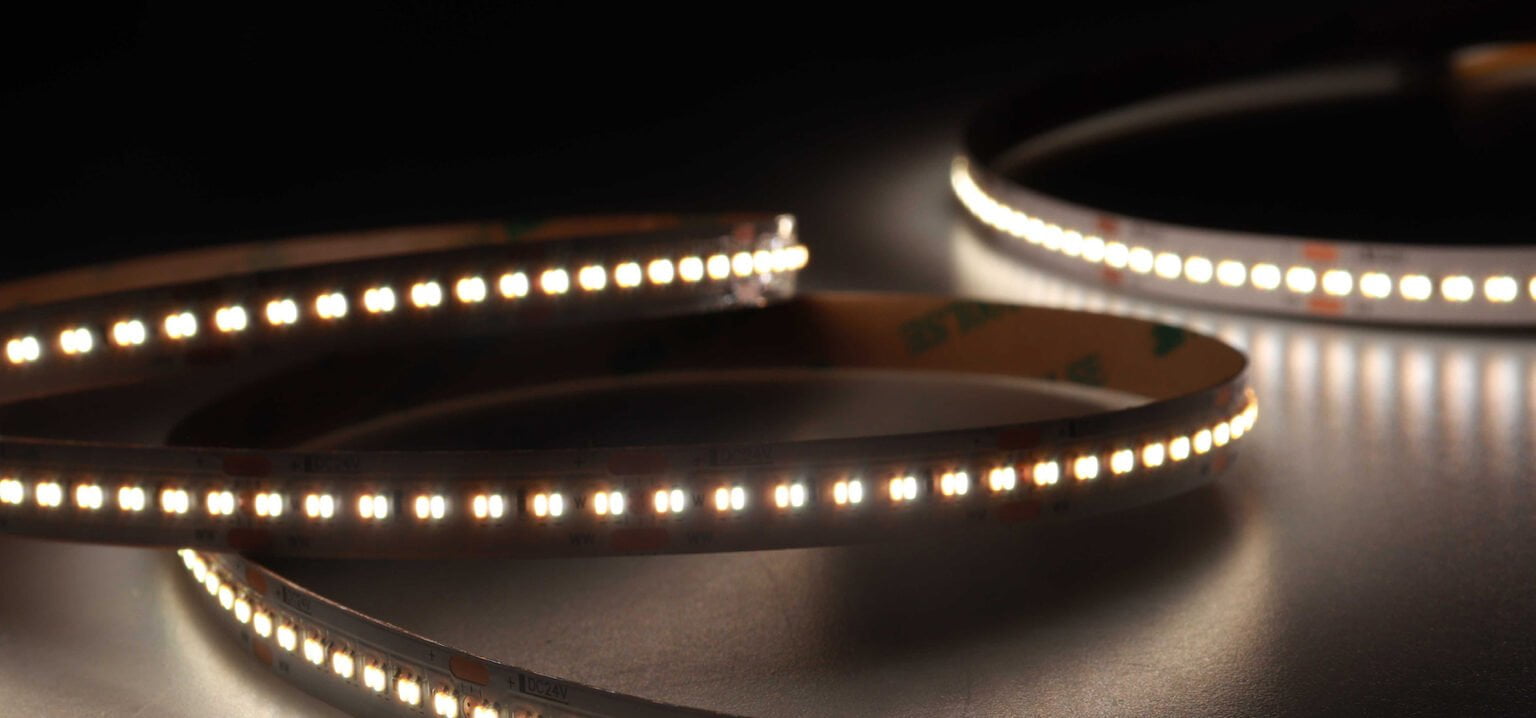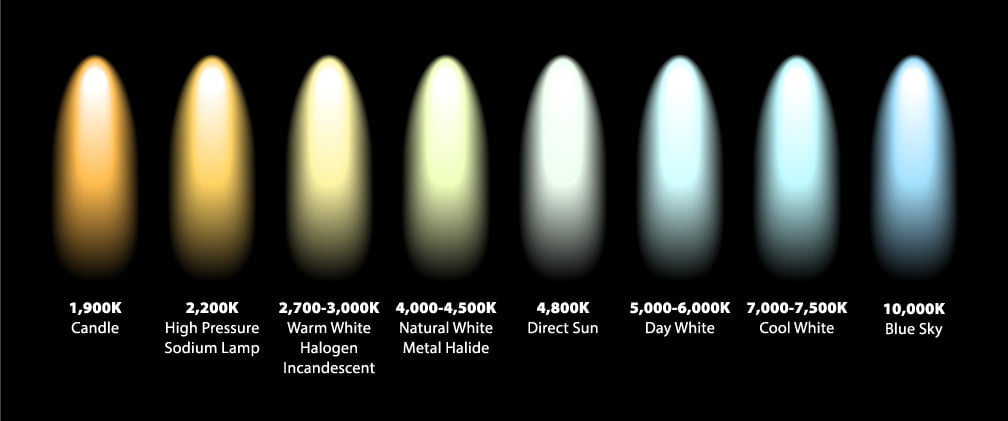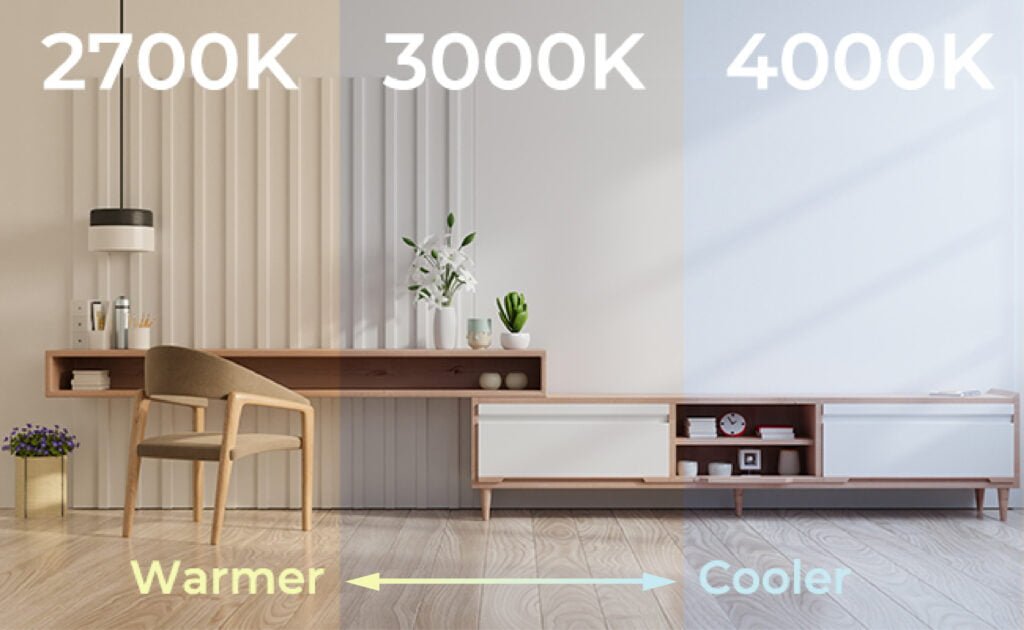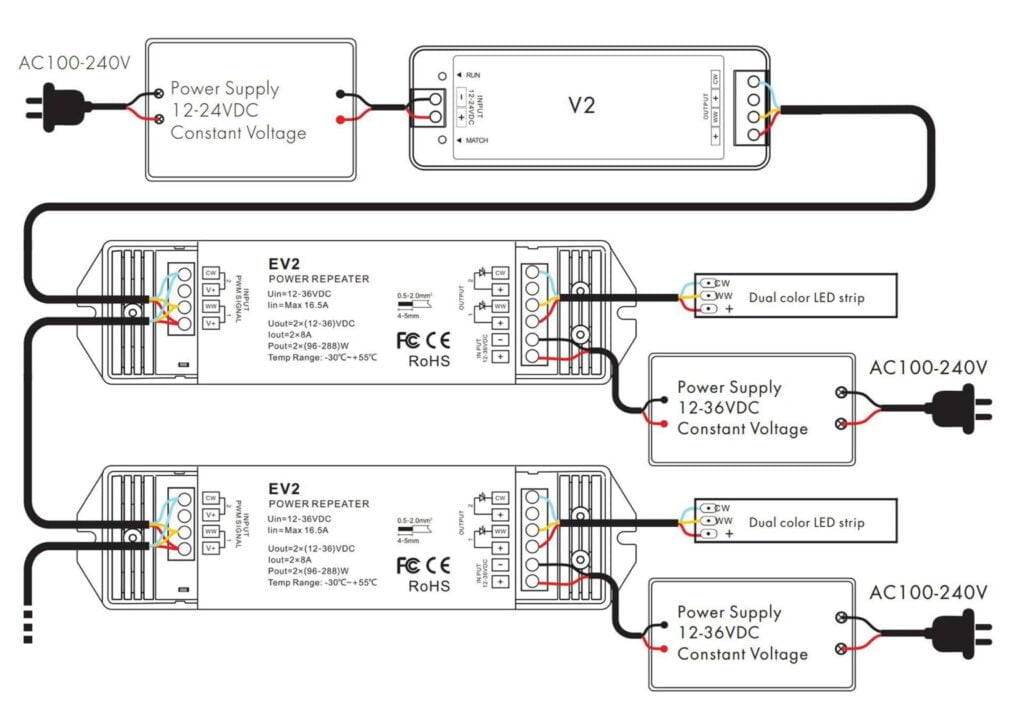Comprehensive Guide to Tunable White LED Strips
Table of Contents
Tunable White Lighting refers to the capability of adjusting the temperature of a light source’s output, which some brands may term as custom temperature color lighting. Various manufacturers produce strip lights embedded with different color temperature LEDs to facilitate tunable white features. This article will serve as an in-depth guide to enhance your understanding of these adaptable white LED strips.
Tunable white LED strips, also known as color temperature-adjustable LED strips, can generate an array of white light hues, extending from warm to cooler tones. The accompanying controller enables easy adjustments to the light color according to your requirements or mood. These strips are energy-efficient and low maintenance, making them suitable for diverse settings like bedrooms, kitchens, bathrooms, offices, and more.
To broaden your understanding of Tunable White LED strips, this article will elaborate on how to purchase, install, and use them. So, let’s delve in!

Concept of Color Temperature and White Light
Typically, LEDs or bulbs come with labels such as warm, cool, daylight, bright white, or soft white, referring to the color temperature of the emitted white light. One must understand the term CCT (Correlated Color Temperature) to comprehend this.
CCT signifies the color temperature of light measured in degrees directly associated with our human perception of white light. CCT accurately depicts the light source color, assisting you in determining whether the specific color will harmonize with your space.
Cool lights are predominantly employed in spaces like offices and libraries, where alertness is required. Conversely, warm lights are frequently utilized in areas intended for relaxation, like hotels and studios.

Understanding Tunable White LED Strips
Tunable white LED strips allude to the LED strips with an adjustable color temperature (CCT), capable of offering a broad spectrum of white lighting. They’re typically 24V adjustable LED strips, and their color temperature can be modified through a DMX controller, a wired or wireless remote control, or both.
These adaptable LED strips are perfect for altering the white color temperature to match varying lighting needs. For instance, a higher color temperature of white light, around 6500K, is ideal for daytime activities in a bedroom. Conversely, a warm tone around 2700K can be chosen for nighttime, helping foster a relaxing ambiance conducive to sleep.

What Determines the CCT changes in Tunable LED Strips?
Correlated Color Temperature, or CCT, is a key factor in comprehending the color transformation process in tunable white LED strips. The different shades of light are attributed to the fluctuations in the CCT ratings. For instance, lower ratings correspond to warmer white hues, while higher ratings equate to cooler tones.
Tunable white LED strips can modulate the ‘temperature’ of the white color, thereby altering the hues between warm and cool white. Nevertheless, crafting a Tunable White LED lighting system involves high complexity and significant effort. A combination of multiple LED outputs is essential to accomplish the desired results. A good-quality tunable device should be capable of generating various temperature levels in Kelvins, along with diverse white light outputs.
The tunable white LED strip incorporates two CCT LEDs. The controller can modulate color temperatures by adjusting the brightness levels of these two CCT LEDs.
A critical factor in achieving the targeted CCT is the blending process. The blending operation can be controlled directly by using the remote to achieve the desired CCT. Formerly, Tunable White LED strips required a warm-up phase to adjust the temperature. However, the current systems, equipped with remote control, are more efficient and faster, allowing real-time control at the press of a button.
Color Temperature for Tunable White LED Strips
The illumination produced by tunable white LED strips corresponds with changes in color temperature. This color temperature is quantified in Kelvin (K), and the light color output varies at various temperatures.
Typically, the CCT for Tunable White LED ranges from 1800K to 6500K or 2700K to 6500K. You can achieve any shade of white light within these ranges, from warm to cool tones. The following table provides an idea of the different white light shades corresponding to the color temperature-
| CCT (1800K-6500K) | Tones Of White |
| 1800K-2700K | Ultra Warm White |
| 2700K-3200K | Warm White |
| 3200K-4000K | Neutral White |
| 4000K-6500K | Cool White |
Managing Tunable White LED Strips
It would help if you had a remote to regulate the tunable white LED strips, which provides several options, such as altering the color temperature or brightness. By integrating these lights into the control structure of your building, you can achieve the desired result. These lights can be adjusted to suit the atmosphere preferred by the inhabitants of the space. The control systems suitable for tunable white LED strips include:
- RF Controller
- RF Remote
- Power Repeater/ Amplifier
- DMX512 & RDM Decoder
You can use any LED controller compatible with your tunable white LED strips to modify the setting to your chosen color temperature. The Kelvin range can be adjusted from 1800K to 6500K to create your desired ambiance.

Advantages of Tunable White LED Strip Lights
Tunable white LED strips are an excellent choice for indoor lighting. Here are some features and benefits of tunable white lights:
Enhanced Mood Setting
Lights have a significant impact on our non-visual senses. Cool or blue lights energize us, while warm white tones are calming. Research suggests that lighting can influence our eating habits in quantity, speed, and frequency. Tunable white LED strips are worth purchasing as they can be adjusted to suit your mood, offering a spectrum from very warm to white light. They suit bedrooms, living rooms, bathrooms, kitchens, etc.
Boosted Productivity
Multiple studies demonstrate that bright lighting aids focus, thereby enhancing work efficiency. Conversely, warm light tends to relax you, reducing concentration. Mild red tones can also improve health and encourage more effective team and creative work. Some research recommends high-tone color settings for morning and afternoon work hours to enhance concentration.
The lighting CCT or brightness level should decrease as the day or night progresses. These are optimal times for relaxation and peace, as melatonin production is prompt. Tunable white LED strips are recommended for adjusting color temperature in meeting rooms to boost attention spans and brainstorming sessions.
Different color temperatures are suitable for different environments:
- 2000K to 3000K is ideal for a warm, cozy ambiance, perfect for bedrooms or dining rooms where comfort and relaxation are key.
- The color temperature should range from 3000K to 4000K for a more formal setting like an office. Cool white light benefits spaces like offices and kitchens that require more focus.
- Consider a color temperature between 4000K and 5000K for a school setting to create a vibrant, enjoyable environment that encourages learning.
Improved Health
Several studies highlight the health benefits of optimal color temperature. It improves sleep, boosts mood, maintains work efficiency, and even affects study habits.
Ideal for Circadian Rhythm
Human beings have developed a biological cycle called circadian rhythms over time under the influence of the sun. This cycle affects body temperature, hormone production, and alertness levels.
The internal clock governs the circadian rhythm and is crucial in managing the levels of various substances throughout the day in a 24-hour cycle. This rhythm resets with external input, such as light, which triggers or halts hormone synthesis. Tunable LED lights are excellent for this, supporting your circadian cycle with the ideal lighting for work and sleep.
Cost-Efficient
Electric lighting has simplified human life by allowing tasks to be completed without waiting for daylight. Depending on your preference, a tunable white LED strip can provide a warmer or cooler tone; it offers an aesthetically pleasing look and is one of the most cost-effective lighting systems with top-tier quality. These LED strips use less energy than traditional incandescent lights, which reduces your electricity bill. With a single lighting system, you get the benefits of both yellow and white lights.

Applications of Tunable White LED Strip Lights
Tunable white LEDs have the versatility to serve a variety of purposes. Some of the most popular uses for tunable white LED strips include –
- Domestic Lighting: Perfect for domestic lighting, tunable LED strips can enhance various rooms such as the bedroom, bathroom, and living room. They offer the added benefit of mood modification. For instance, select a warm hue for your bedroom during the evening for a snug atmosphere. Conversely, opt for a cool white shade that evokes a sense of vigor during productive hours.
- Ambiance Lighting: The tunable white LED strips can also provide ambiance lighting within homes, offices, and business spaces. Their utilization allows for creative experimentation with the overall lighting schema of the premises.
- Business Setting Illumination: In commercial contexts, tunable white LED strips are an excellent choice. They enable you to modify your showroom or outlet’s appearance based on the time of day, offering visitors a refreshing and soothing experience with each visit.
- Accent Lighting: Tunable white LED strips can highlight lighting on staircases, beneath shelves, and within recesses. They enable control over the light color temperature, allowing it to be adjusted according to your preference or requirement.
- Task Lighting: People’s lighting preferences differ, with some favoring warm lighting for its cozy ambiance while others prefer energy-inducing cool lighting. Tunable white LED strips efficiently cater to these diverse preferences. These strips are ideal for workstations and study zones, allowing you to regulate lighting according to your comfort.
- Exhibition and Museum Illumination: Subtle and aesthetic lighting is crucial for museum and exhibition illumination, and tunable white LED strips shine. They can effectively spotlight exhibited items while providing superb accent lighting within museums.
Mastering the Art of Selecting Tunable White LED Strips
Choosing a Tunable White LED Strip may seem straightforward. Still, several aspects should be carefully considered. Low are vital features to remember when in the market for a tunable white LED strip.
Understanding CCT
The Correlated Color Temperature (CCT) informs the light color’s shades at differing temperatures. Tunable white LED strips are typically available in two CCT ranges: 1800K to 6500K and 2700K to 6500K. A higher temperature yields a warmer yellowish light, whereas a lower temperature produces cool white lighting.
Evaluating CRI
The Color Rendering Index (CRI) gives insight into the accuracy of the light color. The higher the CRI, the better the color quality. It’s crucial to select a strip with a CRI of at least 90 to avoid issues with color rendering.
Considering Brightness Level
When evaluating brightness, Lumens is the standard measurement. Therefore, a higher lumen signifies brighter colors. For accent lighting, a range of 200-500lm/m is ideal. For spaces requiring brighter lighting, opt for a higher lumen rating.
Assessing Heat Dissipation
The resilience of your LEDs to overheating is influenced by the quality of the chips they contain. Opting for high-quality ones is generally advised to prevent overheating and potential burnout when temperatures fluctuate.
Analyzing Strip Width & LED Size
The illumination effect of tunable LED strips depends on the strip’s width. For example, a broad LED strip with larger LEDs yields more substantial lighting than a narrower one with smaller LEDs. Therefore, consider the strip width when shopping for tunable LED strips.
Considering LED Density
Low-density LED strips can result in dotted lighting. On the other hand, a tunable LED strip with high density is preferable for its smooth lighting effect. Thus, consider the LED density when selecting, with a preference for higher density.
Checking the IP Rating
The Ingress Protection (IP) rating indicates the protection against liquid and solid particles. A higher IP rating equals enhanced protection. For instance, if you need tunable white LED strips for a bathroom, aim for an IP67 or IP68.
Looking at the Warranty
The product warranty is indicative of product quality and longevity. Therefore, opt for tunable white strips with extended warranty policies. For example, our MyLikeLed tunable white LED strips offer a reassuring 5-year warranty.
Guide to Installing a Tunable White LED Strip
The process of installing a tunable white LED strip is straightforward and uncomplicated. To ensure a seamless installation, gather all necessary equipment beforehand. Below is a concise guide to successfully setting up your tunable white LED strip:
Required Equipment:
- Tunable white LED strips
- Driver
- Receiver
- Controller
Step-1: Understand the Wiring
Tunable white LED strips typically have three wires – a warm white wire, a daylight wire, and a positive wire. Please note that wire colors might differ between manufacturers, so it’s crucial to read the manufacturer’s specifications to identify each wire.
Step-2: Link the Strips to the Receiver
Measure and cut the tunable white LED strips according to your requirements. Use two receivers to connect both ends of the LED strips. There will be identifiable marks on the receiver for each wire. Attach the strip’s warm lighting wire to the receiver’s red negative terminal and the daylight wire to the green negative terminal. Connect the remaining positive wire from the LED strip to the red positive terminal of the receiver.
Step-3: Attach the Receiver to the Driver
On the other end of the receiver, you’ll find two sets of positive and negative input marks. Now, locate the positive and negative wires on the driver and connect them to the corresponding terminals on the receiver. Ensure that the wires are connected cleanly and aren’t touching each other.
Step-4: Link the Controller to the Power Source
After connecting the LED strips with the receiver and driver, it’s time to connect this setup to the controller. Identify the negative and positive ends of the driver and connect them to the controller correctly.
Step-5: Final Check and Setup
Upon finishing the wiring, conduct a test run to make sure the tunable LED strips are working as expected. Once they’ve passed the test, they’re ready to illuminate your space!
Comparing Tunable White LED Strips and Dim-To-Warm LED Strips
Both tunable white and dim-to-warm white LED strips offer exceptional white lighting solutions. However, it can be challenging to select between the two. Don’t fret; the comparison chart below will dispel any confusion you may have-
| Tunable White LED Strip | Dim-to-warm LED Strip |
| Tunable white LED strips can bring warm to cool white light tones. | Dim-to-warm LED strips are designed for adjustable warm white lighting. |
| You can adjust any temperature that falls into the range of tunable white LED strips. | It has a pre-set color temperature. |
| These strips are available in two ranges- 1800K to 6500K & 2700 K to 6500 K. | Dim-to-warm LED strips range from 3000 K to 1800 K. |
| The brightness in tunable white LED strips does not depend on color temperature. So you can control the brightness of every shade. | The highest temperature of Dim-to-warm LED strips is its brightest shade. |
| Tunable white LED strips require a LED controller for adjusting the color temperature. | It is controlled by a dimmer. |
Contrasting Tunable White LED Strips and RGB LED Strips
While tunable white LED strips and RGB LED strips provide unique lighting effects, they differ in several ways. The following points outline these differences:
| Tunable White LED Strips | RGB LED Strips |
| Tunable white LED strip deals with different shades of white. | RGB LED strips consist of a 3-in-1 LED chip. And it deals with colorful lights. |
| Such LED strips have an adjustable color temperature system for switching light colors. | It mixes the three primary colors to create different light effects. |
| The light color range for tunable white LEDs is limited. | The light color range for RGB LED strips is thousands of times more than the tunable ones. |
| It brings white shades from warm to cool tones. | Combining red, green, and blue colors, an RGB LED Strip can make millions of hues! |
| Tunable white LED strips can’t produce colorful lights. They are suitable only for white shades of light. | Besides colorful lighting, RGB can produce white by mixing high intensity red, green, and blue lights. But the white light produced by RGB is not pure white. |
The above points detail the differences between tunable white and RGB LED strips.
Is 1800K-6500K or 2700K-6500K the Better Range for Tunable White LEDs?
When juxtaposing 2700K-6500K and 1800K-6500K tunable white LED strips, the latter provides a broader spectrum of color temperatures, with added options for warm white tones. Hence, if you have a penchant for yellowish-orangey-white light, the 1800K-6500K range could be your superior choice. Placing these in your bedroom can even replicate the soothing ambiance of candlelight at the lowest 1800K setting. However, if warm lighting isn’t your liking, the 2700K-6500K range would be more appropriate.
Conclusion
The popularity of tunable white LED strips is soaring, notably in indoor lighting applications. These versatile illuminations are suitable for bedrooms, bathrooms, kitchens, offices, and commercial spaces, offering users complete command over ambient lighting. Not only do these lighting solutions provide optimum control, but they are also energy-efficient and economical.
For those seeking premium quality tunable white LED strips, MyLikeLed should be your first choice. We offer top-tier tunable white LED strips at competitive prices. All our products undergo rigorous lab testing and come with warranty assurance. Contact MyLikeLed today for further details!
FAQs
Tunable white LED strips work by combining two sets of LEDs—one warm white and one cool white—that can be dimmed independently. By controlling the brightness of each set, you can blend them to achieve the exact shade of white you want.
Tunable white LED strips can usually adjust between 2700K (warm white) and 6500K (cool white). Some high-end models offer an even wider range for more precise lighting customization.
Yes, you need a special controller to manage the two color channels. These controllers allow you to easily adjust brightness and color temperature, either manually, with a remote, or via smartphone apps.
You can use tunable white LED strips in homes, offices, retail stores, and hospitality spaces. They’re great for places where you want flexible lighting, like living rooms, kitchens, workspaces, or even photography studios.
Yes, tunable white LED strips are very energy-efficient compared to traditional lighting. Even with adjustable colors, they use less power and last longer, making them a smart choice for both residential and commercial use.

Hi, I’m Xylia Xiong, a sales professional with 14 years of experience in the LED strip light industry. I specialize in providing tailored solutions, leveraging my expertise in LED products and the latest industry trends. Known for effective communication and problem-solving, I’m dedicated to helping lighting manufacturers, importers, and distributors achieve their goals.
Let’s work together to create customized solutions that exceed expectations.
Related Posts

The Best LED Strip Lights You Can Buy Right Now

Comparing WS2811 Vs WS2812B: Key Differences


